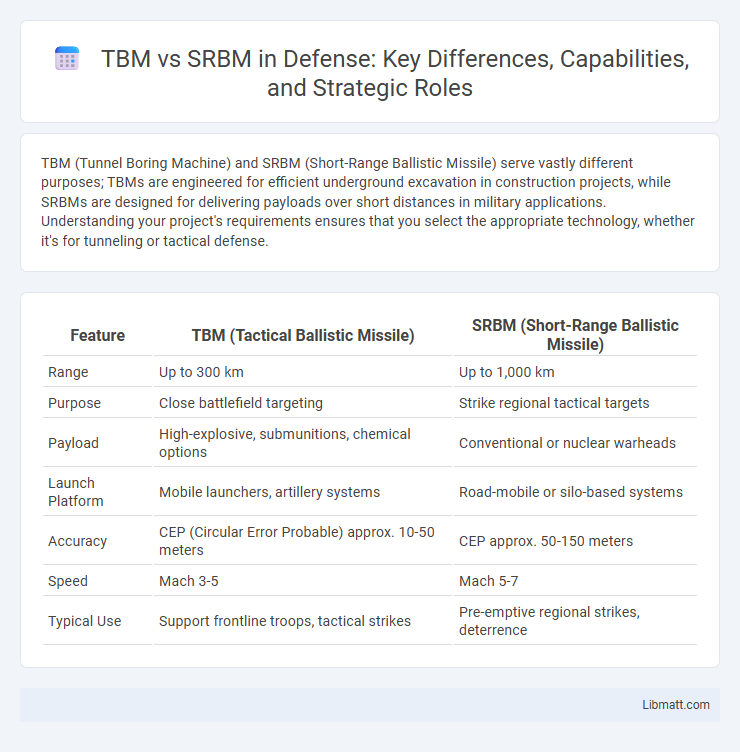TBM (Tunnel Boring Machine) and SRBM (Short-Range Ballistic Missile) serve vastly different purposes; TBMs are engineered for efficient underground excavation in construction projects, while SRBMs are designed for delivering payloads over short distances in military applications. Understanding your project's requirements ensures that you select the appropriate technology, whether it's for tunneling or tactical defense.
Table of Comparison
| Feature | TBM (Tactical Ballistic Missile) | SRBM (Short-Range Ballistic Missile) |
|---|---|---|
| Range | Up to 300 km | Up to 1,000 km |
| Purpose | Close battlefield targeting | Strike regional tactical targets |
| Payload | High-explosive, submunitions, chemical options | Conventional or nuclear warheads |
| Launch Platform | Mobile launchers, artillery systems | Road-mobile or silo-based systems |
| Accuracy | CEP (Circular Error Probable) approx. 10-50 meters | CEP approx. 50-150 meters |
| Speed | Mach 3-5 | Mach 5-7 |
| Typical Use | Support frontline troops, tactical strikes | Pre-emptive regional strikes, deterrence |
Introduction to TBM and SRBM
Tunnel Boring Machines (TBM) are advanced mechanical devices designed for excavating tunnels with precision and efficiency, commonly used in urban infrastructure projects. Short-Range Ballistic Missiles (SRBM) are tactical missiles with ranges typically under 1,000 kilometers, engineered for rapid deployment and targeting in regional conflicts. Understanding the distinct functionalities of TBMs in construction and SRBMs in military applications highlights the specialized roles each technology plays in its respective field.
Defining TBM: Tactical Ballistic Missiles
Tactical Ballistic Missiles (TBMs) are short-range ballistic missiles designed to deliver precise strikes against battlefield targets with ranges typically up to 300 kilometers. TBMs are distinguished by their high speed and ability to carry various warheads, making them effective for rapid tactical operations and disrupting enemy forces. Your understanding of TBMs highlights their role in complementing Strategic Ballistic Missiles (SRBMs), which generally cover longer distances and strategic objectives.
Defining SRBM: Short-Range Ballistic Missiles
Short-Range Ballistic Missiles (SRBMs) are ballistic missiles with ranges up to 1,000 kilometers, designed for rapid, precise strikes over short distances. Tunnel Boring Machines (TBMs), by contrast, are large-scale mechanical devices used primarily for excavating tunnels through rock or soil. Understanding the operational scope of SRBMs versus TBMs highlights the contrast between missile technology and underground construction equipment in military and civil engineering contexts.
Key Differences Between TBM and SRBM
Tunnel Boring Machines (TBM) and Slurry Rock Boring Machines (SRBM) differ primarily in their excavation methods and environmental impact. TBMs use a rotating cutterhead to mechanically excavate soil or rock, creating smooth tunnel walls ideal for large-scale infrastructure projects, while SRBMs rely on a slurry fluid to support the tunnel face and transport excavated material, effectively managing water inflow and unstable ground conditions. The selection between TBM and SRBM depends on geological conditions, tunnel diameter, and project requirements, with TBMs preferred for harder rock and large diameters and SRBMs suited for softer soils and complex water-bearing formations.
Range and Payload Capabilities Comparison
Tunnel Boring Machines (TBMs) and Short-Range Ballistic Missiles (SRBMs) serve vastly different purposes, reflected in their range and payload capabilities. TBMs are engineered for excavation with no offensive payload and operate over indefinite distances underground, while SRBMs are designed to deliver explosive payloads over ranges typically up to 1,000 kilometers. Your choice between these technologies depends on whether the application requires precise tunnel construction or rapid deployment of short-range missile systems.
Deployment and Operational Uses
Tunnel Boring Machines (TBM) are primarily deployed for large-scale, continuous underground excavation projects such as subway tunnels, sewer systems, and underground utilities, offering precision and minimal surface disruption. Short-Range Ballistic Missiles (SRBM) function as rapid-response military assets, designed for tactical strikes with ranges typically below 1,000 kilometers, enabling swift engagement of targets within regional conflict zones. Understanding your project's requirements will guide whether the extensive infrastructure capabilities of TBMs or the agile, strategic applications of SRBMs are most suitable for deployment and operational use.
Tactical Advantages of TBM
Tactical Ballistic Missiles (TBMs) offer superior range and precision targeting over Short-Range Ballistic Missiles (SRBMs), enabling You to strike strategic enemy positions from greater distances with enhanced accuracy. TBMs often feature advanced guidance systems and maneuverability, allowing for evasion of missile defense systems and increased battlefield effectiveness. These capabilities provide a decisive tactical advantage in modern warfare, enhancing your ability to disrupt enemy operations swiftly and effectively.
Strategic Importance of SRBM
Short-Range Ballistic Missiles (SRBMs) provide rapid, precise, and flexible strike capabilities essential for battlefield dominance within ranges up to 1,000 kilometers. Their strategic importance lies in their ability to deliver conventional or nuclear payloads swiftly, enabling effective deterrence and quick response to emerging threats. You can leverage SRBMs for regional security objectives, enhancing your military's operational readiness and force projection.
Technological Innovations and Upgrades
Tunnel Boring Machines (TBM) have seen significant technological upgrades such as advanced sensor integration, automated guidance systems, and enhanced cutterhead designs, enabling higher precision and efficiency in tunnel excavation. In contrast, Single Rocket Boosted Missiles (SRBM) have evolved with improvements in propulsion technology, targeting accuracy, and lightweight composite materials, maximizing range and maneuverability. Your choice between TBM and SRBM depends on the application of cutting-edge innovations tailored to infrastructure versus military technology requirements.
Future Trends in Ballistic Missile Development
Future trends in ballistic missile development emphasize increased accuracy, extended range, and enhanced countermeasure resistance, with TBMs (Theater Ballistic Missiles) evolving to support regional defense via rapid deployment and precision targeting. SRBMs (Short-Range Ballistic Missiles) are advancing toward improved mobility and quick launch capabilities, aligning with asymmetric warfare strategies. Your understanding of these developments is crucial for grasping the shifting balance in missile technology and defense postures.
TBM vs SRBM Infographic

 libmatt.com
libmatt.com